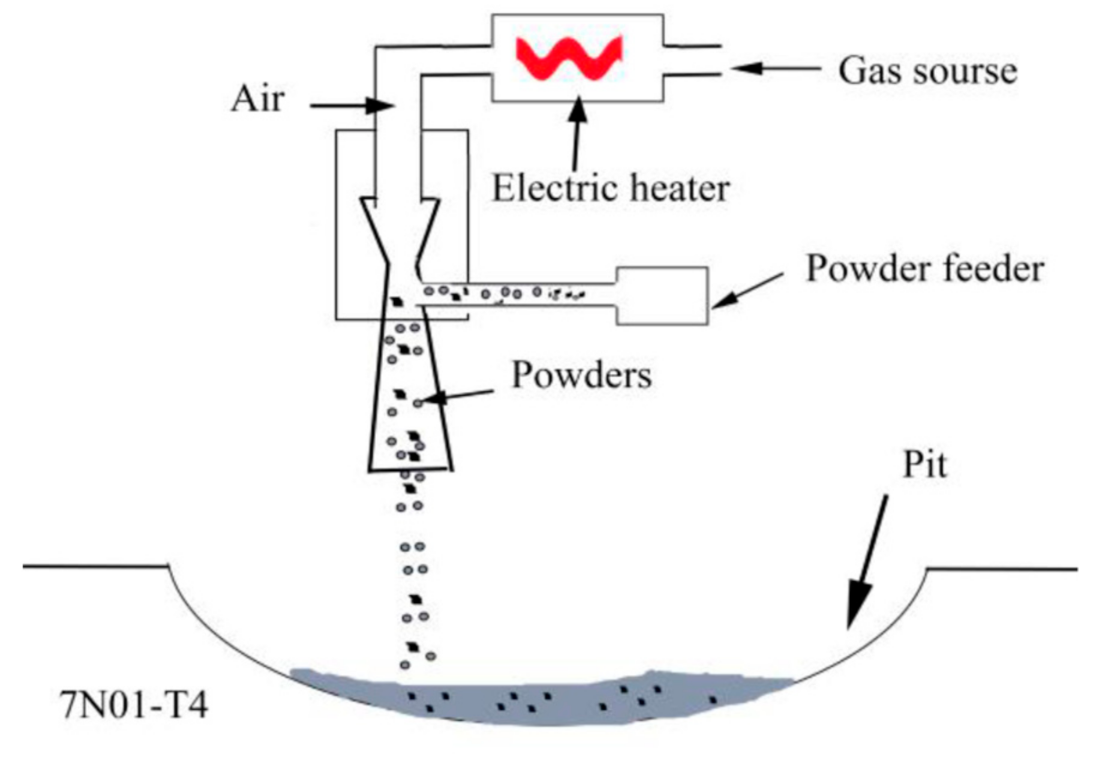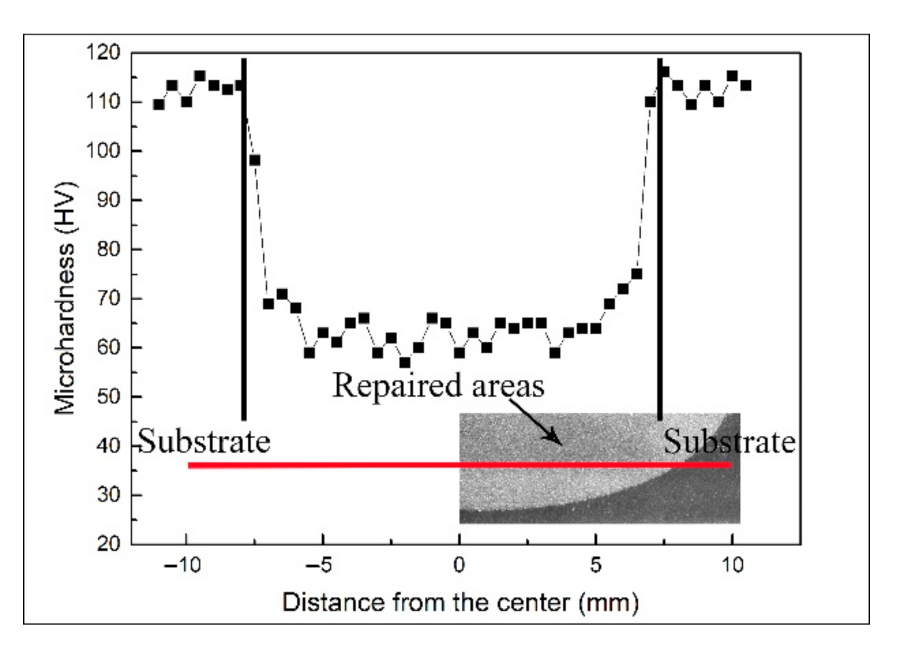A Repair Method for Damage in Aluminum Alloy Structures with the Cold Spray Process
Abstract
:1. Introduction
2. Materials and Methods
2.1. Materials
2.2. Methods
3. Results and Discussion
3.1. Microstructure
3.2. Mechanical Properties
3.3. Corrosion Behavior
4. Conclusions
- (1)
- Damaged samples were successfully repaired through the cold spray process with Al and Al2O3 powders. The microstructure of the repaired areas was dense, and the porosity was relatively low. The tensile strength was markedly improved compared with that of the unrepaired damaged samples.
- (2)
- The rate of mass loss of the samples repaired with the cold spray process was lower than that of 7N01-T4. The repaired areas had a lower corrosion tendency than that of the nearby substrate. The samples repaired with the cold spray process showed better corrosion resistance.
- (3)
- The cold spray process is a promising method for repairing damage in aluminum alloy structures.
Author Contributions
Funding
Institutional Review Board Statement
Informed Consent Statement
Data Availability Statement
Conflicts of Interest
References
- Sun, X.-G.; Han, X.-H.; Dong, C.-F.; Li, X.-G. Applications of aluminum alloys in rail transportation. In Advanced Aluminum Composites and Alloys; Dobrzański, L.A., Ed.; Intechopen: London, UK, 2021; Volume 9, pp. 251–268. [Google Scholar]
- Wang, J.-B.; Zhang, J.; Zhang, Y.; Xie, F.; Krajnovi, S.; Gao, G.-J. Impact of bogie cavity shapes and operational environment on snow accumulating on the bogies of high-speed trains. J. Wind Eng. Ind. Aerod. 2018, 176, 211–224. [Google Scholar] [CrossRef]
- Wu, X.-Y.; Zhang, Z.-Y.; Qi, W.-C.; Tian, R.-Y.; Huang, S.-M.; Shi, C.-Y. Corrosion behavior of SMA490BW steel and welded joints for high-speed trains in atmospheric environments. Materials 2019, 12, 3043. [Google Scholar] [CrossRef] [Green Version]
- Sun, C.-C.; Zhou, X.-L.; Xie, C. Effect of processing conditions on Al-based amorphous/nanocrystalline coating by cold-spraying. Surf. Coat. Technol. 2019, 362, 97–104. [Google Scholar] [CrossRef]
- Liu, Z.-Y.; Wang, H.-Z.; Haché, M.; Irissou, E.; Zou, Y. Formation of refined grains below 10 nm in size and nanoscale interlocking in the particle-particle interfacial regions of cold sprayed pure aluminum. Scr. Mater. 2020, 362, 96–100. [Google Scholar] [CrossRef]
- Jenkins, R.; Yin, S.; Aldwell, B.; Meyer, M.; Lupoi, R. New insights into the in-process densification mechanism of cold spray Al coatings: Low deposition efficiency induced densification. J. Mater. Sci. Technol. 2019, 35, 427–431. [Google Scholar] [CrossRef]
- Rao, Y.-Q.; Wang, Q.; Oka, D.; Seshadri Ramachandran, C. On the PEO treatment of cold sprayed 7075 aluminum alloy and its effects on mechanical, corrosion and dry sliding wear performances thereof. Surf. Coat. Technol. 2020, 383, 125271. [Google Scholar] [CrossRef]
- Michael Shockley, J.; Rauch, E.F.; Chromik, R.R.; Descartes, S. TEM microanalysis of interfacial structures after dry sliding of cold sprayed Al-Al2O3. Wear 2017, 376–377, 1411–1417. [Google Scholar] [CrossRef]
- Ngai, S.; Ngai, T.; Vogel, F.; Story, W.; Thompson, G.B.; Brewer, L.N. Saltwater corrosion behavior of cold sprayed AA7075 aluminum alloy coatings. Corros. Sci. 2018, 130, 231–240. [Google Scholar] [CrossRef]
- Balani, K.; Laha, T.; Agarwal, A.; Karhikeyan, J.; Munroe, N. Effect of carrier gases on microstructural and electrochemical behavior of cold-sprayed 1100 aluminum coating. Surf. Coat. Technol. 2005, 195, 272–279. [Google Scholar] [CrossRef]
- Zhang, Z.-C.; Liu, F.-C.; Han, E.-H.; Xu, L. Mechanical and corrosion properties in 3.5% NaCl solution of cold sprayed Al-based coatings. Surf. Coat. Technol. 2020, 385, 125372. [Google Scholar]
- Cong, D.-L.; Li, Z.-S.; He, Q.B.; Chen, H.-B.; Zhao, Z.-P.; Zhang, L.-P.; Wu, H.-L. Wear behavior of corroded Al-Al2O3 composite coatings prepared by cold spray. Surf. Coat. Technol. 2017, 326, 247–254. [Google Scholar] [CrossRef]
- Michael Shockley, J.; Desarties, S.; Vo, P.; Irissou, E.; Chromik, R.R. The influence of Al2O3 particle morphology on the coating formation and dry sliding wear behavior of cold sprayed Al-Al2O3 composites. Surf. Coat. Technol. 2015, 270, 324–333. [Google Scholar] [CrossRef]
- Campbell, J.P.; Astarita, A.; Viscusi, A.; Saha, G.C. Investigation of strain-hardening characteristics of cold-sprayed Al-Al2O3 coatings: A combined nanoindentation and expanding cavity models approach. Surf. Eng. 2019, 36, 1022–1031. [Google Scholar] [CrossRef]
- Daroonparvar, M.; Farooq Khan, M.U.; Saadeh, Y.; Kay, C.M.; Kasar, A.K.; Kumar, P.; Esteves, L.; Misra, M.; Menezes, P.; Kalvala, P.R.; et al. Modification of surface hardness, wear resistance and corrosion resistance of cold spray Al coated AZ31B Mg alloy using cold spray double layered Ta/Ti coating in 3.5 wt% NaCl solution. Corros. Sci. 2020, 176, 109029. [Google Scholar] [CrossRef]
- Leger, P.E.; Sennour, M.; Delloro, F.; Borit, F.; Debray, A.; Gaslain, F.; Jeandin, M.; Ducos, M. Multiscale experimental and munerical approach to the powder particle shape effect on Al-Al2O3 coating build-up. J. Therm. Spray Technol. 2017, 26, 1445–1460. [Google Scholar] [CrossRef]
- Perna, A.S.; Viscusi, A.; Astarita, A.; Boccarusso, L.; Carrino, L.; Durante, M.; Sansone, R. Manufacturing of a metal matrix composite coating on a polmer matrix composite through cold gas dynamic spray technique. J. Mater. Eng. Perform. 2019, 28, 3211–3219. [Google Scholar] [CrossRef]
- Champagne, V.K. The repair of magnesium rotorcraft components by cold spray. J. Fail. Anal. Prev. 2008, 8, 164–175. [Google Scholar] [CrossRef]
- ISO. 11130: 2017—Corrosion of Metals and Alloys—Alternate Immersion Test in Salt Solution; ISO: Geneva, Switzerland, 2017. [Google Scholar]
- ISO. 17475: 2005—Corrosion of Metals and Alloys—Electrochemical Test Methods—Guidelines for Conducting Potentiostatic and Potentiodynamic Polarization Measurements; ISO: Geneva, Switzerland, 2005. [Google Scholar]
- Lee, H.Y.; Jung, S.H.; Lee, S.Y.; You, Y.H.; Ko, K.H. Correlation between Al2O3 particles and interface of Al-Al2O3 coatings by cold spray. Appl. Surf. Sci. 2005, 252, 1891–1898. [Google Scholar] [CrossRef]
- Xie, X.-L.; Hosni, B.; Chen, C.-Y.; Wu, H.-J.; Li, Y.-L.; Chen, Z.; Verdy, C.; Kedim, O.E.I.; Zhong, Q.-D.; Addad, A.; et al. Corrosion behavior of cold sprayed 7075Al composite coating reinforced with TiB2 nanoparticles. Surf. Coat. Technol. 2020, 404, 126460. [Google Scholar] [CrossRef]
- Qiu, X.; Tariq, N.; Qi, L.; Tang, J.-R.; Cui, X.-Y.; Du, H.; Wang, J.-Q.; Xiong, T.-Y. Influence of particulate morphology on microstructure and tribological properties of cold sprayed A380/Al2O3 composite coatings. J. Mater. Sci. Technol. 2020, 44, 9–18. [Google Scholar] [CrossRef]
- Rokni, M.R.; Widener, C.A.; Champagne, V.K.; Crawford, G.A.; Nutt, S.R. The effects of heat treatment on 7075 Al cold spray deposits. Surf. Coat. Technol. 2017, 310, 278–285. [Google Scholar] [CrossRef]
- Zhang, Z.-C.; Liu, F.-C.; Han, E.-H.; Xu, L.; Uzoma, P.C. Effects of Al2O3 on the microstructures and corrosion behavior of low-pressure cold gas sprayed Al 2024- Al2O3 composite coatings on AA 2024-T3 substrate. Surf. Coat. Technol. 2019, 370, 53–68. [Google Scholar] [CrossRef]
- Tao, Y.-S.; Xiong, T.-Y.; Sun, C.; Jin, H.-J.; Du, H.; Li, T.-F. Effect of α-Al2O3 on the properties of cold sprayed Al/α-Al2O3 composite coatings on AZ91D magnesium alloy. Appl. Surf. Sci. 2009, 256, 261–266. [Google Scholar] [CrossRef]
- Meydanoglu, O.; Jodoin, B.; Kayali, E.S. Microstructure, mechanical properties and corrosion performance of 7075 Al matrix ceramic particle reinforced composite coatings produced by the cold gas dynamic spraying process. Surf. Coat. Technol. 2013, 235, 108–116. [Google Scholar] [CrossRef]
- Da Silva, F.S.; Bedoya, J.; Dosta, S. Corrosion characteristics of cold gas spray coatings of reinforced aluminum deposited onto carbon steel. Corros. Sci. 2017, 114, 57–71. [Google Scholar] [CrossRef] [Green Version]
- Spencer, K.; Fabijanic, D.M.; Zhang, M.-X. The use of Al-Al2O3 cold spray coatings to improve the surface properties of magnesium alloys. Surf. Coat. Technol. 2009, 204, 336–344. [Google Scholar] [CrossRef]
- Mao, S.-D.; Yang, H.-X.; Song, Z.-L.; Li, J.-L.; Ying, H.-G.; Sun, K.-F. Corrosion behaviour of sintered NdFeB deposited with an aluminum coating. Corros. Sci. 2011, 53, 1887–1894. [Google Scholar] [CrossRef]
- Tao, Y.-S.; Xiong, T.-Y.; Sun, C.; Kong, L.-Y.; Cui, X.-Y.; Li, T.-F.; Song, G.-L. Microstructure and corrosion performance of a cold sprayed aluminum coating on AZ91D magnesium alloy. Corros. Sci. 2010, 51, 3191–3197. [Google Scholar] [CrossRef]
- Yang, X.-W.; Li, W.-Y.; Yu, S.-Q.; Xu, Y.-X.; Hu, K.-W.; Zhao, Y.B. Electrochemical characterization and microstructure of cold sprayed AA5083/Al2O3 composite coatings. J. Mater. Sci. Technol. 2020, 59, 117–128. [Google Scholar] [CrossRef]
- Walter, G.W. Laboratory simulation of atmospheric electrochemical techniques example results. Corros. Sci. 1991, 32, 1331–1352. [Google Scholar] [CrossRef]
- Wang, X.-J.; Zhang, L.-Y.; Zhou, X.-L.; Wu, W.; Jie, X.-H. Corrosion behavior of Al2O3-reinforced graphene encapsulated Al composite coating fabricated by low pressure cold spraying. Surf. Coat. Technol. 2020, 386, 125486. [Google Scholar] [CrossRef]
- Norrell, T.; Ferguson, G.; Ansell, T.; Saladin, T.; Nardi, A.; Nieto, A. Synthesis and corrosion behavior of cold sprayed dual nanoparticles reinforced Al coatings. Surf. Coat. Technol. 2020, 401, 126280. [Google Scholar] [CrossRef]
- Bai, X.-M.; Tang, J.-Q.; Gong, J.-M.; Lü, X.-L. Corrosion performance of Al-Al2O3 cold sprayed coatings on mild carbon steel pipe under thermal insulation. Chin. J. Chem. Eng. 2017, 25, 533–539. [Google Scholar] [CrossRef]











| Si | Fe | Cu | Mn | Mg | Cr | Zn | Ti | Al |
|---|---|---|---|---|---|---|---|---|
| ≤0.30 | ≤0.35 | ≤0.20 | 0.2–0.7 | 1.0–2.0 | ≤0.30 | 4.0–5.0 | ≤0.20 | Bal. |
| Materials | Tensile Strength/MPa | Elongation/% |
|---|---|---|
| 7N01-T4 | 435.1 ± 3.4 | 17.2 ± 2.3 |
| UR | 188.5 ± 5.5 | 3.8 ± 1.1 |
| CS | 241.4 ± 10.1 | 2.6 ± 1.2 |
| Materials | Rate of Mass Loss/mg·cm−2 | |
|---|---|---|
| 168 h | 504 h | |
| 7N01-T4 | 0.1279 | 0.2023 |
| UR | 0.2151 | 0.3057 |
| CS | 0.1029 | 0.1558 |
| Materials | Ecorr (VSCE) | Icorr (μA/cm2) | ||
|---|---|---|---|---|
| 168 h | 504 h | 168 h | 504 h | |
| 7N01 | −1.037 | −1.004 | 0.9301 | 0.8213 |
| The repaired areas in CS samples | −0.965 | −0.893 | 0.7004 | 0.6021 |
Publisher’s Note: MDPI stays neutral with regard to jurisdictional claims in published maps and institutional affiliations. |
© 2021 by the authors. Licensee MDPI, Basel, Switzerland. This article is an open access article distributed under the terms and conditions of the Creative Commons Attribution (CC BY) license (https://creativecommons.org/licenses/by/4.0/).
Share and Cite
Han, X.; Sun, X.; Li, G.; Huang, S.; Zhu, P.; Shi, C.; Zhang, T. A Repair Method for Damage in Aluminum Alloy Structures with the Cold Spray Process. Materials 2021, 14, 6957. https://doi.org/10.3390/ma14226957
Han X, Sun X, Li G, Huang S, Zhu P, Shi C, Zhang T. A Repair Method for Damage in Aluminum Alloy Structures with the Cold Spray Process. Materials. 2021; 14(22):6957. https://doi.org/10.3390/ma14226957
Chicago/Turabian StyleHan, Xiaohui, Xiaoguang Sun, Gangqing Li, Shiming Huang, Ping Zhu, Chunyuan Shi, and Tengfei Zhang. 2021. "A Repair Method for Damage in Aluminum Alloy Structures with the Cold Spray Process" Materials 14, no. 22: 6957. https://doi.org/10.3390/ma14226957
APA StyleHan, X., Sun, X., Li, G., Huang, S., Zhu, P., Shi, C., & Zhang, T. (2021). A Repair Method for Damage in Aluminum Alloy Structures with the Cold Spray Process. Materials, 14(22), 6957. https://doi.org/10.3390/ma14226957






